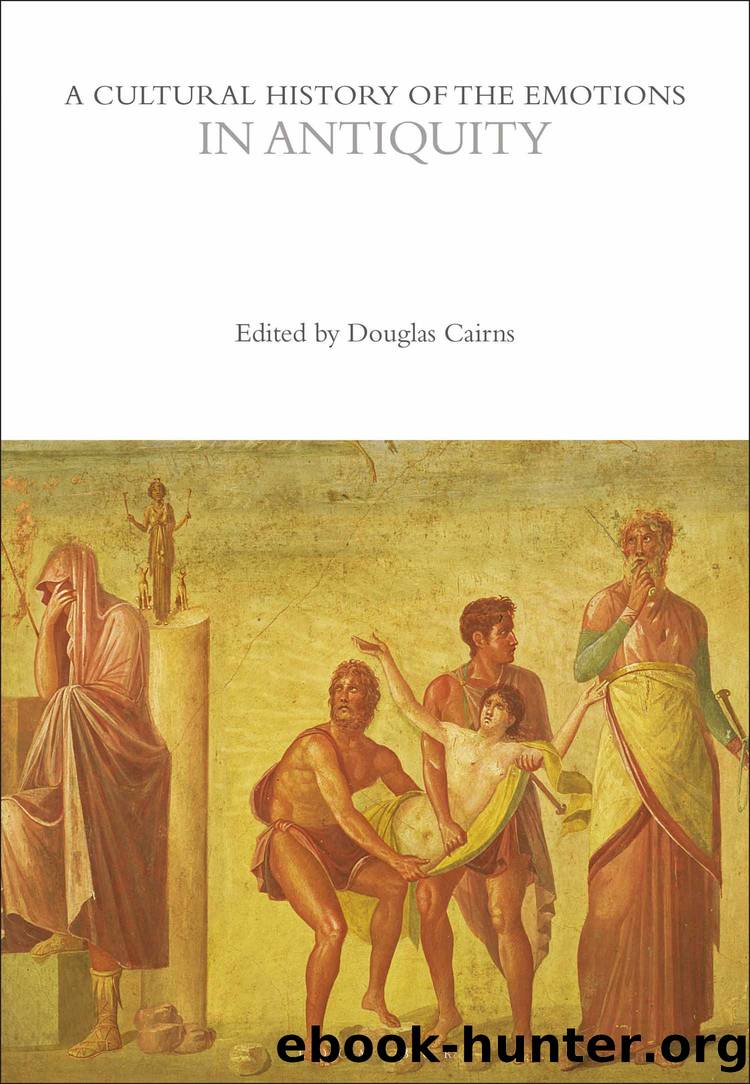A Cultural History of the Emotions in Antiquity by Douglas Cairns;

Author:Douglas Cairns; [Cairns, Douglas]
Language: eng
Format: epub
ISBN: 9781350091641
Publisher: Bloomsbury UK
Published: 2021-11-29T00:00:00+00:00
I hate and I love. Why do I do this, perhaps you ask?
I donât know, but I feel it happen and am tortured.
Although the vicissitudes of the emotional life were part of what seemed so problematic about emotions to ancient philosophers, for poets and other authors, the contradictory and puzzling quality of emotions was precisely what made them so fascinating and fertile for exploration.5 How can one hate and love simultaneously? It is a familiar fact, yet the speaker himself cannot explain it. The hypothetical interlocutor is confused as well, though in choosing the active verb âdoâ instead of the passive âhappen,â he seems to suggest the speakerâs role in causing his own distress. In a more general way, the question posed by the unnamed interlocutor again invites readers to ask questions of their own, whether about the speakerâs emotional extremes or their own experiences.
This chapter will focus on a representative three emotions: pity, wonder, and disgust. Ancient literary and philosophical analysis concerned itself extensively with pity; disgust is not theorized at all, although it is hardly absent from literary texts; wonder is especially interesting because while it is usually viewed positively, sometimes it features in polemic as a sort of cheap trick. First, however, we shall look briefly at how literary emotion works in ancient thought.
Most of the core assumptions of later literary/rhetorical theory about the emotions are already implicit in the Homeric epics. The epics present a wide variety of typically intense emotions and indicate them both explicitly, through narratorial intervention, and through the speech, behavior, and physiological reactions of characters. Of course, there is no theory of emotion in Homer. Early Greek does not have a word even roughly synonymous with âemotion,â and epic language does not clearly distinguish emotive from cognitive states. That does not mean, however, that Homer did not understand the emotions as related to each other. The emotions of epic characters are located mostly in the thumos, which is both a physical entity or substance in the chest and something less material and precise. Although the thumos also does cognitive work, the expression âarouse the thumosâ always indicates a strong emotional reaction, whether anger, pity, or grief, and points to a unity among the emotions.
The range of emotion in the epics is wide. Besides anger, the theme of the Iliad, we see nemesis, the special form of anger felt at a violation of social norms; fear; confidence; desire; joy; pity; grief; pride; surprise; regret; aidôs (inhibitory shame); impatience; amazement; and pothos, longing for something absent.
Homer frequently describes the physiological correlates of emotions, both those visible to others and those not (Iliad 15.101â2 is an unusually precise case). Both Hector and Andromache laugh when their baby is frightened by the plume of his fatherâs helmet at Iliad 6.471. Then, after Hectorâs prayer for his son, Andromache takes the baby while âlaughing through tearsâ at Iliad 6.483. Hector evidently interprets her tears as a sign that she is afraid for him (she has already begged him not to fight so aggressively).
Download
This site does not store any files on its server. We only index and link to content provided by other sites. Please contact the content providers to delete copyright contents if any and email us, we'll remove relevant links or contents immediately.
The Daily Stoic by Holiday Ryan & Hanselman Stephen(3110)
The Fate of Rome: Climate, Disease, and the End of an Empire (The Princeton History of the Ancient World) by Kyle Harper(2872)
People of the Earth: An Introduction to World Prehistory by Dr. Brian Fagan & Nadia Durrani(2619)
Ancient Worlds by Michael Scott(2493)
Babylon's Ark by Lawrence Anthony(2430)
Foreign Devils on the Silk Road: The Search for the Lost Treasures of Central Asia by Peter Hopkirk(2388)
The Daily Stoic by Ryan Holiday & Stephen Hanselman(2343)
India's Ancient Past by R.S. Sharma(2295)
MOSES THE EGYPTIAN by Jan Assmann(2275)
The Complete Dead Sea Scrolls in English (7th Edition) (Penguin Classics) by Geza Vermes(2135)
Lost Technologies of Ancient Egypt by Christopher Dunn(2111)
The Earth Chronicles Handbook by Zecharia Sitchin(2101)
24 Hours in Ancient Rome by Philip Matyszak(1973)
Alexander the Great by Philip Freeman(1960)
Aztec by Gary Jennings(1877)
The Nine Waves of Creation by Carl Johan Calleman(1783)
Curse Tablets and Binding Spells from the Ancient World by Gager John G.;(1768)
Before Atlantis by Frank Joseph(1740)
Earthmare: The Lost Book of Wars by Cergat(1715)
